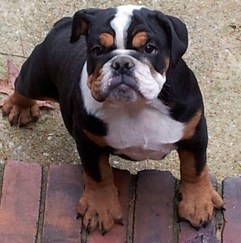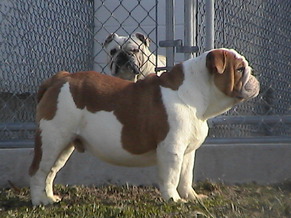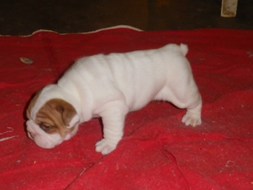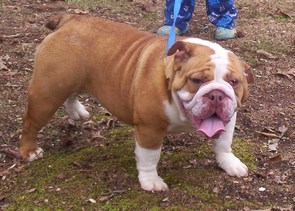TRI BULLIES
- About
AT TRI BULLIES The tan point pattern is caused by a recessive gene on the Agouti series gene locus, the following are the alleles (variations) that are definitely known to occur in the ENGLISH BULLDOG. There are also a couple of other genes on this same locus, but they are most likely not present in this breed, so we will ignore them in this article to try and keep things simple.
Agouti locus alleles present in the BULLDOG
A- Dominant Black: produces a solid color (ie.black, chocolate or blue
ay - Dominant Yellow - Produces reds and buckskins
at - Tan-Point (recessive)- produces solid color with tan 'points'
A dog needs to inherit two copies of the tan-point gene to be a black & tan. If a pup inherits one copy of the gene and one copy of the dominant yellow gene, which causes a red or buckskin coloration, then the dog will be red or buckskin, not black and tan. If the dog inherits one copy of the tan-point gene and one of the dominant black gene, the result will be a solid black dog. because of the recessive nature of the tan-point gene, it can actually remain hidden in the gene pool for many generations without expressing itself. In the case of our breed (where this is not a common color) this is what often happens, but it is important to realize that when the tan-point pattern does pop up it is not some new color mutation that appeared out of nowhere, but rather the manifestation of a gene that has been present in this breed all throughout the known history of the English Bulldog. Though it is impossible to say for sure where the coloration originated, our best guess would be that it came from some sort of terrier blood that was introduced many, many years ago, probably during the early formation of the breed in the British Isles.
Actually, part of the reason the color is uncommon is that there has been a distinct prejudice against it by many people, either because they feel it is not a typical English Bulldog color, or even actually thought it was the result of a mixed breeding. The latter reason shows an ignorance of basic genetic principles, because the gene is recessive, there is no way you could breed a Rottweiler or a Doberman or Manchester Terrier to a English Bulldog and get puppies with the tan-point markings unless the Bullie was carrying the tan- point gene too. If in fact the black and tan color was not present in the English Bulldog gene pool, you would have to breed to a dog of another tan-point breed, and then breed two offspring from such a breeding back together to get black & tan dogs, in the first generation you would get no tan-pointed offspring.
The tan point gene does not actually create a black & tan animal, the gene itself does not produce any color but rather a pattern of a solid color with light-colored 'points'. These 'points' always appear in specific places but the actual size and distribution of them is somewhat variable. The exact coloration that is produced by the tan-point gene is dependent on the color genes present at other loci, for instance if the pigmentation is black, the result will be a black & tan, but if the dog's pigmentation is chocolate or blue then the pattern would produce a chocolate & tan or a blue & tan, respectively.
THE FOLLOWING INFORMATION ON DETERMINING COLORS WAS DERIVED FROM A VARIETY OF DOG REGISTRIES AND OTHER WEBSITES
BLUE CARRIERS
The D locus is the primary locus associated with diluted pigment, which results in coats that would otherwise be black or brown instead showing up as gray, or blue in the case of black, and pale brown or Isabella in the case of brown. The melanophilin gene has recently been shown to be responsible, but not all of the dilute causing mutations have been identified yet.
CHOCOLATE GENE.
B Locus
The B locus is responsible for the presence of brown, chocolate, or liver animals. It is also responsible for nose color. The gene associated with this locus is known as TYRP1. In breeds where the A locus does not come into play, any animal that has at least one B allele (and is not "ee"), will be black in pigmented coat. Those dogs, which have two copies of any of several b alleles will be brown. There are at least three such b alleles. Regardless of other loci, any animal with at least one B allele will have a black nose and pads, while those with any two b alleles will have a liver nose and pads
TRI BULLIES BREEDING GOALS
Black with Tan Points
AKC
TRI BULLIE MOJO
AKC
TRI BULLIE MOJO


TRI BULLIE BRUTE
DNA'd Dd, AT and AY
he carry blue and also tan points
brother to Tri Bullie MOJO
DNA'd Dd, AT and AY
he carry blue and also tan points
brother to Tri Bullie MOJO

This boy is a Full Chocolate that carry Blue,Black and Tan points

ay / a - Dog is fawn and carries recessive black